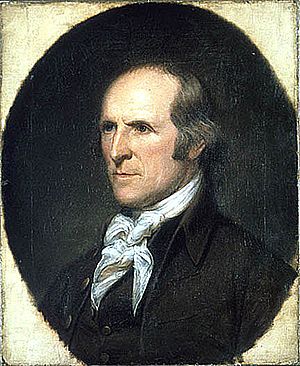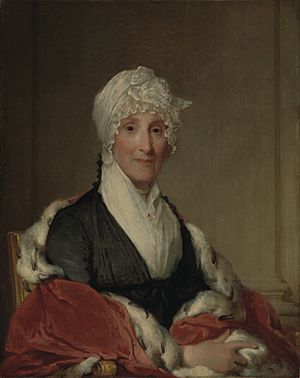Timothy Pickering facts for kids
Quick facts for kids
Timothy Pickering
|
|
|---|---|

Portrait by Charles Willson Peale, 1792
|
|
| 3rd United States Secretary of State | |
| In office December 10, 1795 – May 12, 1800 Ad interim: August 20 – December 10, 1795 |
|
| President | George Washington John Adams |
| Preceded by | Edmund Randolph |
| Succeeded by | John Marshall |
| 2nd United States Secretary of War | |
| In office January 2, 1795 – December 10, 1795 |
|
| President | George Washington |
| Preceded by | Henry Knox |
| Succeeded by | James McHenry |
| 5th United States Postmaster General | |
| In office August 12, 1791 – January 1, 1795 |
|
| President | George Washington |
| Preceded by | Samuel Osgood |
| Succeeded by | Joseph Habersham |
| United States Senator from Massachusetts |
|
| In office March 4, 1803 – March 3, 1811 |
|
| Preceded by | Dwight Foster |
| Succeeded by | Joseph Bradley Varnum |
| Member of the U.S. House of Representatives from Massachusetts |
|
| In office March 4, 1813 – March 3, 1817 |
|
| Preceded by | Leonard White |
| Succeeded by | Nathaniel Silsbee |
| Constituency | 3rd district (1813–15) 2nd district (1815–17) |
| Personal details | |
| Born | July 17, 1745 Salem, Massachusetts Bay, British America |
| Died | January 29, 1829 (aged 83) Salem, Massachusetts, U.S. |
| Political party | Federalist |
| Children |
|
| Education | Harvard University (BA) |
| Signature |  |
| Military service | |
| Allegiance | |
| Branch/service | Massachusetts militia Continental Army United States Army |
| Years of service | 1766–1785 |
| Rank | Colonel |
| Battles/wars | American Revolutionary War |
Timothy Pickering (July 17, 1745 – January 29, 1829) was an important American politician. He served as the third United States Secretary of State under Presidents George Washington and John Adams. He also represented Massachusetts in both the United States Senate and the United States House of Representatives as a member of the Federalist Party.
Born in Salem, Massachusetts, Pickering studied law at Harvard University. He became a county judge and an officer in the local militia. During the American Revolutionary War, he was a key leader in the Continental Army, serving as Adjutant General and Quartermaster General. After the war, he moved to Pennsylvania and helped with the state's decision to approve the Constitution of the United States.
President Washington appointed Pickering as United States Postmaster General in 1791. He later became United States Secretary of War and then United States Secretary of State in 1795. As Secretary of State, Pickering believed the U.S. should have strong ties with Britain. President Adams removed him from office in 1800 because Pickering disagreed with making peace with France during the Quasi-War.
Pickering was elected to the United States Senate in 1803. He strongly opposed the Embargo Act of 1807, which stopped American trade with other countries. He continued to support Britain during the Napoleonic Wars. After leaving the Senate in 1811, he served in the United States House of Representatives from 1813 to 1817. During the War of 1812, he was a leader in the New England movement that led to the Hartford Convention. After this, his political career ended. He spent his final years as a farmer in Salem.
Contents
Early Life and Career
Timothy Pickering was born in Salem, Massachusetts. He was one of nine children. He went to grammar school in Salem and graduated from Harvard College in 1763. One local minister described him as "assuming, turbulent, & headstrong" even when he was young.
After college, Pickering worked for the town clerk in Salem. He became a lawyer in 1768 and later took over as the county's record keeper. He was also elected to represent Salem in the Massachusetts General Court (the state legislature) and served as a judge. In 1766, he married Rebecca White.
In 1766, Pickering joined the Essex County militia as a lieutenant. He was promoted to captain three years later. In 1769, he shared his ideas on how to train soldiers in a local newspaper. These ideas were published as "An Easy Plan for a Militia" in 1775. This training guide was used by the Continental Army until a new one was created by Baron von Steuben.
Role in the American Revolution
Early Confrontations
On February 26, 1775, Pickering's militia was involved in an early event of the American Revolution, known as "Leslie's Retreat." British soldiers from Boston came to Salem looking for hidden weapons. Pickering's militia and local citizens stopped the British from crossing a bridge. A local minister helped convince the British commander to leave peacefully. This prevented a fight that could have started the war even earlier.
Two months later, Pickering's troops marched to the Battles of Lexington and Concord, but they arrived too late to join the main fighting. They then became part of the army that surrounded Boston during the siege.
Serving General Washington
In December 1776, Pickering led his well-trained militia regiment to New York. General George Washington noticed his skills and offered him a job as adjutant general of the Continental Army in 1777. He was given the rank of colonel. In this role, he helped oversee the building of the Great Chain. This huge chain blocked the Hudson River, stopping British ships from attacking the important fort at West Point.
Pickering was praised for his work in supplying the troops throughout the war. In August 1780, the Continental Congress chose him to be the Quartermaster General. This meant he was in charge of getting all the supplies the army needed.
Rising in Government
After the American Revolution, Pickering tried different business ventures, but they didn't succeed. In 1786, he moved to Pennsylvania and held several important local offices. In 1787, he was part of the Pennsylvania meeting that decided to approve the Constitution of the United States.
President Washington appointed Pickering as a commissioner to the Iroquois Native Americans. Pickering helped the United States negotiate the Treaty of Canandaigua with the Iroquois in 1794.
Serving in the Cabinet
In 1791, President Washington brought Pickering into his government as United States Postmaster General. Pickering stayed in the cabinets of both Washington and John Adams for nine years. He was Postmaster General until 1795, then briefly United States Secretary of War in 1795. After that, he became United States Secretary of State from 1795 to 1800.
As Secretary of State, he was known for his strong support of British interests. He was even willing to go to war with France to support Britain during the Adams administration.

In May 1800, President John Adams fired Pickering. This happened after they disagreed about Adams's plan to make peace with France.
Later Political Career
In 1802, Pickering and some other Federalists were unhappy with the government. They tried to get support for New England to leave the United States. Pickering was elected to the United States Senate as a senator from Massachusetts in 1803. He was a member of the Federalist Party.
He strongly opposed President Jefferson's Embargo Act, which stopped American trade. Pickering believed this act was harmful. He also thought the U.S. taking over Spanish West Florida in 1810 was wrong and against the Constitution.
Near the end of his Senate term, Pickering was criticized for reading private government documents in a public Senate meeting. Because of this, the Senate officially criticized him on January 2, 1811.
Serving in Congress
Pickering was later elected to the United States House of Representatives in 1812, where he served until 1817. During the War of 1812, he was a leader in the New England movement that led to the Hartford Convention. This meeting discussed New England's concerns about the war.
Final Years
After he was not re-elected in 1816, Pickering retired to Salem, Massachusetts. He lived as a farmer until he passed away in 1829 at the age of 83.
Legacy and Recognition
- In 1799, Fort Pickering in Salem, Massachusetts, was named after him.
- In 1942, a United States Liberty ship (a type of cargo ship) was named the SS Timothy Pickering. It was lost near Sicily in 1943.
- Until the 1990s, the Pickering House in Salem, built around 1651, was the oldest house in the United States continuously owned by the same family.
See also
 In Spanish: Timothy Pickering para niños
In Spanish: Timothy Pickering para niños
- France–United States relations
- Federalist Party
- List of United States senators expelled or censured

